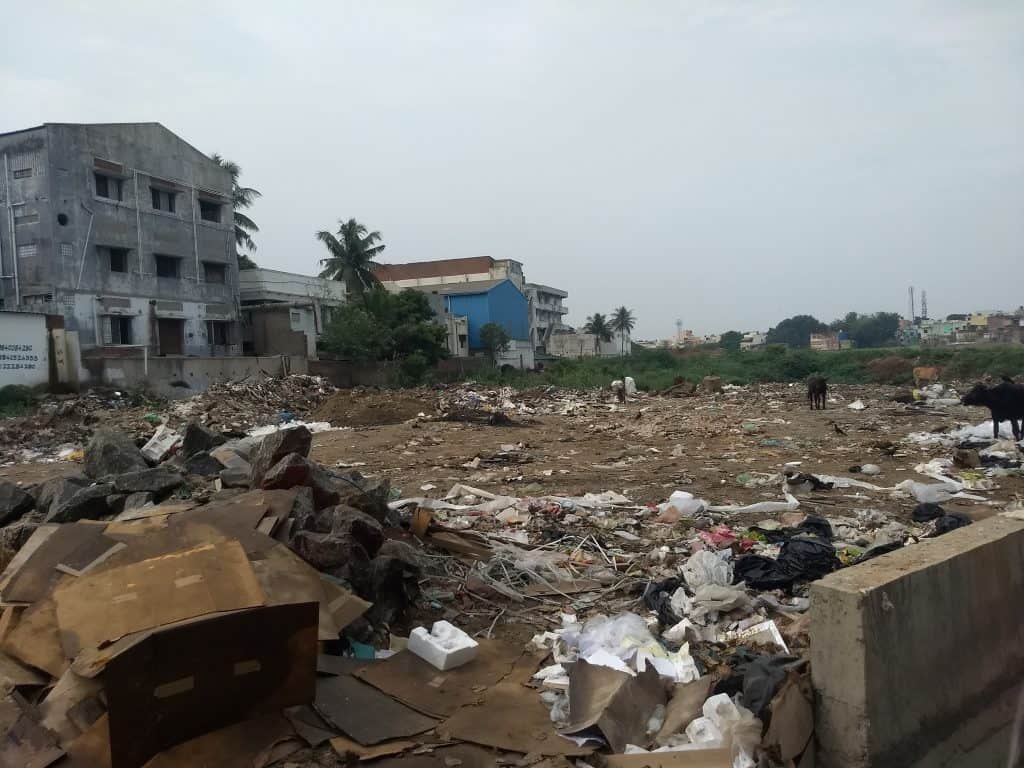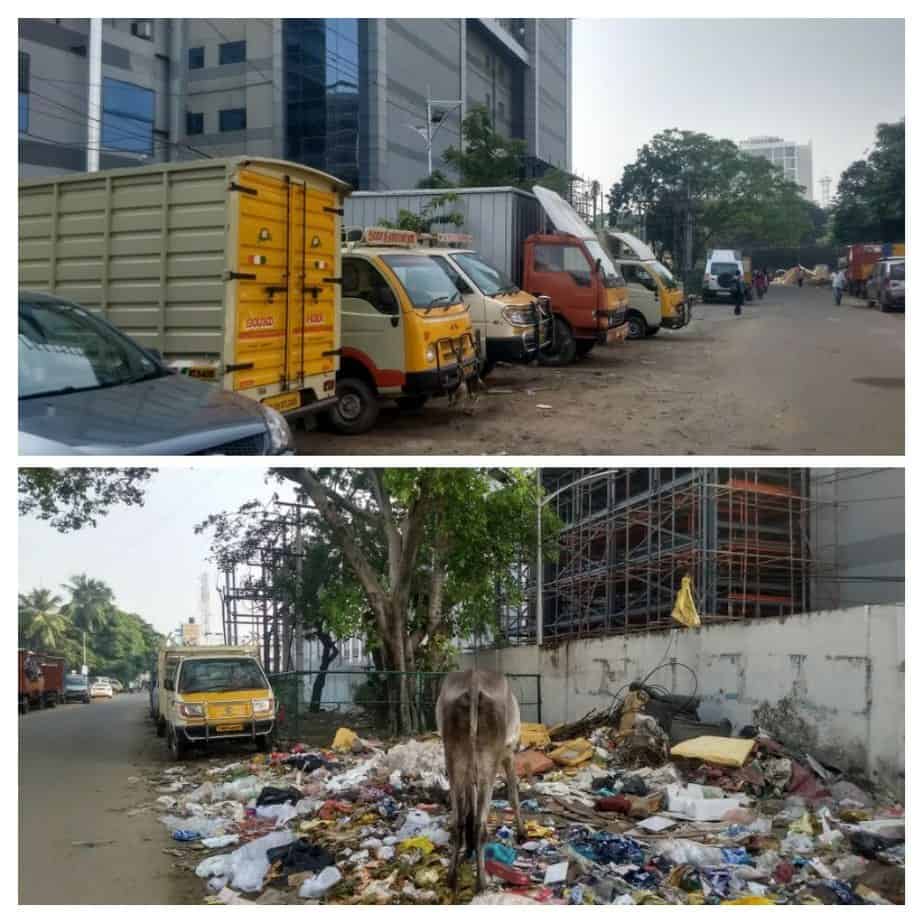Every Chennaiite feels a sense of pride and excitement when crossing Kathipara, Asia’s largest cloverleaf flyover that connects several arterial roads at the all important Guindy junction. Just a few yards from Kathipara in Guindy is the Guindy industrial estate, a hub for small and medium scale industries. But a ride inside the estate premises makes you wonder if this locality, with its toxic waste mountains, dangling EB wires and haphazardly parked vehicles is even in Chennai. Such is the stark contrast between the Kathipara area and the Guindy estate.

Cardboards, plastic covers, electrical wires and what not. This empty spot in Guindy Industrial Estate speaks about the callousness of the SIDCO.
Now and then
Touted as Asia’s first production cluster, Guindy Industrial estate has a chequered history. Old timers recall the once neat roads of the estate, with greenery on either side. Stanley Vinod Kumar, who resided at Sundar Nagar, a few metres away from the estate jurisdiction around 40 years ago says, “Chemical industries and printing press units were scattered across the estate. Small Industries Development Corporations (SIDCO), the nodal agency, was effective in maintaining the roads. There was no littering. Deer could be spotted occasionally towards the bus stand in the estate.”
Unfortunately, these sights are a thing of the past now, as the estate is now an ill-maintained locality, though still preferred by citizens for its proximity to many localities and educational institutions. There is no choice but to put up with the shoddy civic infrastructure. A small shower is enough to turn the roads into shambles. The road adjoining the Olympia Tech Park is filled with potholes and heaps of garbage from residential and commercial outlets.
Any resident will tell you about the unabated dumping of waste on the roads. Mandatory segregation of waste imposed by the Chennai Corporation last year has a whole new meaning in the estate — waste pickers collect recyclables from garbage dumps, cows graze on the vegetable waste, flies and mosquitoes squat over the residual reject waste. The usable space of the roads has shrunk, as garbage occupies a large part of it.
This continues to be the scenario, unless someone complains to SIDCO. Dogged by lack of funds, SIDCO in turn forwards the calls to Chennai Corporation to clear the mini waste villages.
Role of SIDCO
SIDCO, which once used to employ conservancy workers to clear the garbage has outsourced it to private contractors now. Since they suffer a huge funds crunch, according to informed sources, there is a chronic shortage of staff — the reason why the estate is in a mess.
SIDCO receives land for a considerably cheap price from the government, and is supposed to develop the physical infrastructure for all utilities before selling it to entrepreneurs — the only move that fetches them revenue. Their responsibility then is to coordinate with different departments to ensure that the estate is maintained well. But residents are far from happy.
A resident of Ambal Nagar, who has been dumping his household garbage at the road behind Olympia Tech Park, blames SIDCO officials for systemic glitches. “There are no bins. Door-to-door collection of garbage is not effective, as the collectors come at an odd time. I can’t let my house stink,” he says.
The pictures below are a stark portrayal of the state of infrastructure in the estate today.

Behind the Olympia Tech Park: Lorries parked on pedestrian space and cattle grazing at a garbage dump.
Unkept promises
SIDCO however is loath to hand over the reins to Chennai Corporation for maintenance. Whenever a picture of neglect is published by any media, they clean up the mess temporarily. Permanent solution, however, is a far cry.
Trucks and lorries that carry goods to these industries are parked randomly, leading to traffic chaos. If a written complaint is submitted, the area manager and the team inspect the locality, warn the truck owners and clear the road. Such measures leave the roads free for a maximum of two days.
The body took forever to design a parking strategy for the trucks. Only recently did the area manager, Bharathi of SIDCO, assure citizens that parking would not create a problem, as charges would be collected from mid-October. However, there is no transformation evident till date, as heavy vehicles continue to remain parked everywhere.
Efforts in vain
Olympia Tech Park, Deccan Chronicle and a team of residents had submitted multiple complaints to SIDCO about the poor management. Olympia Tech Park, as part of its CSR initiative, volunteered to take on the greening of dumping sites by planting trees, if SIDCO would permit that. Permission was granted for one stretch of the road, after months of persuasion.
Pictures of poor management sent by this reporter to top officials of SIDCO including the former Managing Director of SIDCO, Apoorva IAS and Additional Chief Secretary, SIDCO, Mangat Ram Sharma met with no fruitful response.
“We left no stone unturned. We volunteered to work with SIDCO on the issues of garbage and parking management. But there has been very late or little response,” said a senior official from Olympia Tech Park.
Traders hit hard
For the traders, who learnt entrepreneurship in the estate, moving out is a tough choice. The slippery potholes during rains and stagnant roads are something they put up with, year after year. But why?
T Ranganathan, who owns an electronics shop said that the estate works out to be economical for them. “Since it is a hotspot in terms of location of office spaces, it offers great chances for budding entrepreneurs to build their business. Poor civic amenities are a minus, but we have no choice,” Ranganathan says.
But their livelihood does get hit hard by civic issues sometimes. “The potholes in front of my shop are the reason why I lost many customers, especially motorists,” says a trader who sells groceries in Poomagal Main Road. The pothole filled, garbage littered road provides a horrendous ride for the motorists, who prefer to not go that way.
E Ramarajan, who supplies water cans says that the EB wires dangling in front of his shop pose a great risk, especially during rains.
With such issues putting hundreds of entrepreneurs, thousands of residents and road users in a spot, the future of SIDCO appears uncertain.